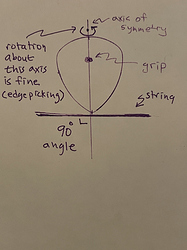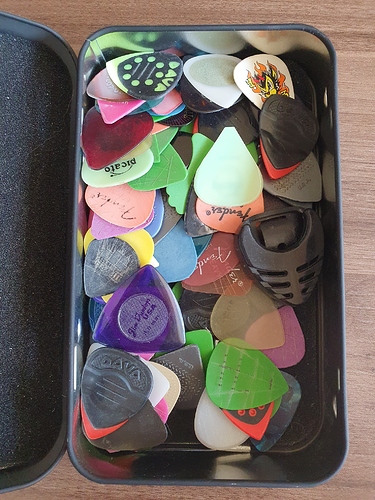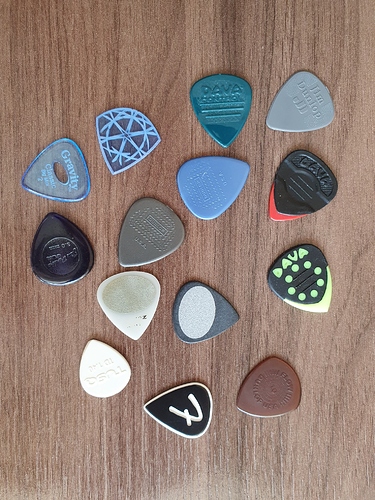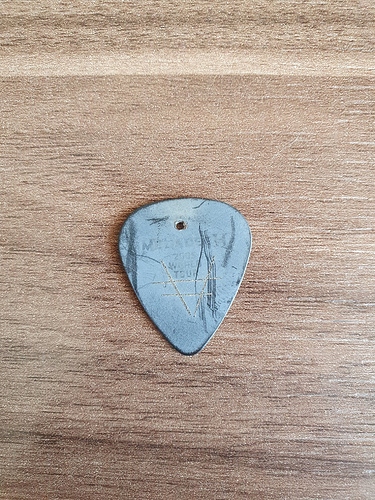Thanks for the response.
Seems there are some advantages to the picking grip you are using that I wouldn’t have thought of.
I may give this a try and see if I can make it work. Only way to find out if I can make it work is give it a try!
Hopefully it works out for you. I can’t promise results because everyone has different hands but it’s worked fairly well for me so far.
Hi, im new here but i saw your post online and joined to see if i can help you and others with pick issues!
Try a new pick called “The Pick Plus”. it has a horizontal slot to create skin to skin contact and it prevents rotation with its grip space and Plus handle.
There are three models- Standard, Pro and Elite. I’d recommend the Pro or Elite model for you since you are confident otherwise in your grip. Look for those on the website.
ThePickPLus
Any questions or feedback, let me know!
My experience with this problem involved a downward pickslant position combined with a long ingrained string-hopping habit.
As I performed the upstroke, my muscle memory would make my hand ever-so-slightly push inwards (or ‘bounce’) towards the guitar’s body.
Combined with the DWPS position, this meant that the trailing edge of the pick made blunt contact with the string in a way that shoved the pick point towards the headstock. Even a single botched upstroke could cause a radical pick rotation.
In short, the problem wasn’t the pick itself or the grip I was using. It was string-hopping sneaking up on me.
I hope this is helpful to someone.
Hey thanks for the response.
That’s interesting, how did you manage to diagnose the problem? It seems like something that would be quite hard to spot. When I play in USX (DWPS), my pick point is never straight, it goes slightly positive (towards headstock). I don’t mind this so much though, but if it goes the other way I’m in trouble as it feels like the pick is catching in the strings and then gets pushed further and further until there is no pick left to pick with. I’m making a lot of technique alterations right now though so maybe in time and practice, I’ll figure it all out.
Just stumbled across this thread - I had horrible problems with the pick rotating while playing for decades, until I discovered CTC. CTC inspired/guided me to fix a lot of the inefficiencies in my picking motion, and once I did that, the pick rotation disappeared completely. Its not that it got better and I gradually overcame it - it just disappeared, it never happens now, and I never even have to think about it.
I’m convinced that unwanted pick slippage is a symptom of inefficient technique, not a problem on its own, simply because I’ve never heard a pro player complain about this issue. They’ll say they still struggle with unwanted tension, or they aren’t as accurate as they’d like to be sometimes, but they’ll never say “oh, yeah, i constantly fight to keep the pick in position”.
I don’t know how to explain this mechanically. My best guess is that efficient picking technique is symmetrical with respect to up and down strokes, and that this symmetry causes equal and opposite pick-rotating forces over time. That is, if the down stroke pushes the pick out of position in one direction, the up stroke does the opposite, and the average effect is thus zero. But who knows. If someone wanted to post slow motion magnet video of pick-rotation occurring, it could be very interesting to see where and when it occurs.
Anyway, enough speculation. My advice to you is to ignore the pick rotation and focus on improving the efficiency of your picking, and see if it doesn’t go away on its own.
One more thought: A common response to this problem is “you’re gripping too tight”, and less often, “you’re gripping too loose”. I’m almost certain this is not the answer. Why? Because if I intentionally over- or under-grip the pick, it doesn’t rotate at all. If I grip reeeeeeeally loosely, the pick will gradually retreat into my grip, but it doesn’t rotate while doing so.
Thanks for that very detailed response!
I’m actually going through the primer again as I’ve got certain things backwards and there has been a big update in it since I last went through it. I am almost certain now that it is down to inefficient motion and not how I hold the pick or what type I use. At an early stage of the primer, I already see that I’ve been trying to force a primary motion to work, when it seems something else actually comes a little more natural to me.
Dumbass me created another thread about almost the same issue, forgetting about this thread and how it’s basically the same issue 
Maybe it could be merged…?
This is a problem I battled with for nearly 30 years. In my case the diagnosis was simple, although overcoming the problem took a while. And it was thanks to CTC that I realised my problem - the episode with the old video of Troy picking with the trailing edge. I looked down and low and behold that’s how I was picking. I would start off fine but gradually my forefinger would extend until eventually I was just pinching the pick between the flat of my straight finger and my thumb, so there was really nothing providing support and the pick could turn. I immediately changed to a leading edge picking motion. At first it was hard because overcoming decades of habit takes work, but after some months it became natural.
For the last 5 or 6 years I’ve had very few problems with the pick turning. Occasionally my forefinger wants to unfold and my grip begins to slip, but at least I now know how to correct it.
Thanks for sharing.
I think my issues may stem from just not having certain picking motions right just yet. I just began going through the primer again recently and some things I misunderstood the first time round. Also, it’s expanded quite a bit since the first time I went through it.
I suspect that a combination of things could be causing it, not having motions correct yet which would also mean that my natural instinct to put pressure on certain parts of the pick will need to develop as I correct these motions. Hopefully that will do the trick anyway… We shall see in the months to come.
I noticed that my pick doesn’t turn at all because of symmetry. It is absolutely normal to the string, and by this I mean if you drew a line through the axis of symmetry of the pick (a line that goes exactly through the point and then exactly through the middle of the top) this hits the string at exactly 90 degrees. I put grip pressure centered along this same line as well. My picks (Dunlop Flow 2.0mm) have tiny dots as well to enhance friction. So, my upstroke and downstroke are indistinguishable from the perspective of the pick, hence it can’t have a preferred direction of rotation. I am guessing that you hit the string where this angle is less than 90 degrees. Hopefully this makes sense, but I drew a picture in case it helps one to understand. Does this help? 
For a different perspective from @kgk, I have the point of the tip more forward. Definitely something to experiment with.
Is the CTC terminology for this called ‘pick-point’?? I remember thi coming up at some point, but didn’t follow up on it…
@PickingApprentice Honestly I’m not sure, I don’t see it talked about anywhere near as much as picking motions and escape mechanics.
I think that if you look at my thumb the pick might look somewhat as you describe, but basically I adjust my grip so that the pick always points straight down at the strings. In my world view the pick “needs” to hit the string at 90 degrees, and my thumb will hold it accordingly. By pinching the pick along the middle axis everything is quite stable and it won’t rotate even with a very lax grip, although as I mentioned, my picks do have tiny raised dots on them to hinder movement.
Hey thanks for that explanation and drawing! I’ll do some experimenting tomorrow and see if I have understood you correctly. I was actually thinking about trying out some new picks also, not just for grip, but for some tonal options also. I think I’ll add the Dunlop Flow 2mm to the list as I’ve seen them mentioned a few times now!
Thanks again for your explanation and hopefully I’ve understood it correctly!
Yes that is what’s referred to as pick point in the primer. Some forms can cause the pick to either be positive (towards the headstock) or negative (towards the bridge)
So, if you extend your wrist, you may need to dial in some negative pick point, extremely slightly, or it may happen automatically as you play.
But if you play with a flexed wrist, you might need to dial in positive pick point, or again it may just happen by itself.
In some of the videos, you can see the positive pick point that some Gypsy jazz players have and if I have understood things correctly, it would be mostly down to the flexion of the wrist.
Hope that makes sense!
I have had problems with the pick rotating in my hand as long as I remember holding a pick.
My observations and thoughts:
- Troy is right that when you are alternating pick strokes the forces are balancing themselves so the pick will find an equilibrium position. However, if you are only downpicking using edge picking (i.e. hitting the string with only one edge of the pick) there is no balancing force and it will tend to move in the opposite direction.
- Accepting this fact, you need to deal somehow with it. No arguing with the laws of physics

- One obvious way is to grip harder. However, you have limit so how hard you can grip and still avoid tensing you whole hand
- To lessen the needed gripping you can use picks that have a surface with higher friction. I have tried each and evey one I have come accross. So far I’m most satisfied with Dunlop MaxGrip Nylon and Dunlop Flow.
Also, someone said that the big guys don’t complain from pick rotation. Well, I was lucky enough to get a Megadeth pick from a concert and guess what - it has deep knife scratches on both sides. So, I guess they don’t complain publicly but nevertheless have to deal with it. Which is why in the past I started scratching my picks with a knife. It works just fine, so if you don’t want to change brands and materials - there you have it. Keep in mind that the scratches smoothen over time and you need to renew them.
I have also tried the Monster Grips but find that the rubber gets rather slippery when you fingers are sweaty. - Another way is to use a grip with bigger contact area with the fingers. I find that angled padding (I think this is what Troy called it) provides that.
- Finally, most riffs have natural breaks in them - longer notes and chords - that give you the opportunity to readjust the pick
I’ll add pictures (and anything I have forgotten to mention) later.
You are totally right. There are situations where the pick is not going to be say 90degrees to the string.
I find that when using a medium supinated arm setup, the pick tends to go a little positive. Not a crazy amount, but just enough so that the upstrokes feel similar to the downstrokes. Trying to force the pick to be 90degrees, it doesn’t feel smooth at all and I can’t go fast.
I also noticed, when using the angle pad grip, if I used too much of the pad, almost like a pad to pad grip but not quite, the pick would have to go very positive to feel smooth. I’m guessing due to the difference in where I’m holding the pick giving naturally less edge picking and also the medium supinated arm setup. I have since fixed my grip a little after watching the video in the forearm and wrist picking section. The angle pad grip is explained again and it clicked with me that I didn’t have the contact points quite right.
Anyways, yes, if you look for it, you can see great players adjusting grip, or at least it appears that’s what they are doing, between some phrases. I notice it with Frank Gambale. I can’t say for certain that’s what he is doing, but it appears he may be, extremely quickly, adjusting the grip.
Did you ever try the Ibanez sand grip picks? I tried them for a while but found the sand grip would wear off after a few days and then felt a little slippery.






